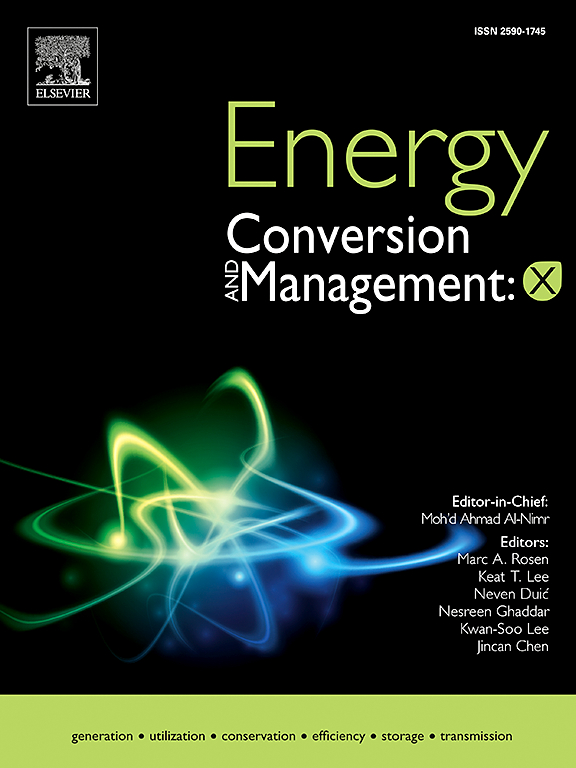住宅逆变器、光伏和电池发电的LVDC背靠背系统的开发和实验室验证
IF 7.6
Q1 ENERGY & FUELS
引用次数: 0
摘要
本研究的重点是消费者接口单元:一个低压背靠背(B2B)转换器,集成了光伏(PV)发电,电池存储,以及可能的其他直流负载,同时,解耦电网连接并向低压消费者供电。本文探讨了直流母线电压调节和电流管理的复杂性。该系统采用最大功率点跟踪(MPPT)来优化太阳能收集,并利用DC-DC升压转换器来放大光伏系统的电压。这提高了可靠性,特别是对于低压(交流/直流)系统。电池存储管理是通过使用DC-DC降压-升压转换器来实现的,即使在太阳辐射波动的情况下,也能确保稳定的电源供应。在Simulink中对并网机组和整个电源管理系统进行了仿真。在Simulink中进行了全面的仿真,并通过快速原型平台进行了实验室验证,证明了该系统在两种操作模式下提供稳定高效电力的能力。将复杂的控制算法整合到现有的电源管理框架中,增强了对负载和太阳能波动的响应能力,确保了在不同条件下的峰值性能。另外的技术改进是根据转换器中包含的igbt支腿的数量对dc链路进行微调。这种改进可以更准确地调节电压水平,减少开关损耗并提高整体能源效率。该系统的模块化设计便于直接扩展,允许未来的扩展,如集成更多的可再生能源或增加存储能力。这一战略不仅满足了当前住宅用户的需求,也为未来的智能电网解决方案奠定了基础,促进了一个更强大、更灵活的能源网络。本文章由计算机程序翻译,如有差异,请以英文原文为准。
Development and laboratory validation of an LVDC back-to-back system with residential inverter, PV, and battery-based power generation
This study focuses on a consumer interface unit: a low-voltage (LV) back-to-back (B2B) converter that integrates photovoltaic (PV) generation, battery storage, and possibly other DC loads and, at the same time, decouples grid connection and supply to LV consumers. The present work explores the complexities of regulating the voltage of the DC bus and managing the current. The system employs Maximum Power Point Tracking (MPPT) to optimize solar energy harvesting and utilizes a DC-DC boost converter to amplify the voltage of the PV system. This enhances the dependability, particularly for LV (AC/DC) systems. Battery storage management is accomplished by utilizing a DC-DC buck-boost converter, ensuring a consistent power supply even in the presence of solar irradiation fluctuations. The grid-connected unit and the complete power management system (PMS) were simulated in Simulink. Thorough simulations in Simulink and laboratory validations through a rapid prototyping platform, demonstrate the system’s ability to deliver stable and efficient power in both operational modes. The incorporation of sophisticated control algorithms into the existing power management framework enhances responsiveness to fluctuations in load and solar energy, ensuring peak performance under varying conditions. Additional technical improvements have been made by fine-tuning the DC-link based on the number of IGBT-legs incorporated in the converter setup. This refinement enables more accurate regulation of the voltage levels, reducing switching losses and boosting overall energy efficiency. The system’s modular design facilitates straightforward scalability, allowing for future expansions like the integration of more renewable energy sources or increased storage capabilities. This strategy not only meets the present demands of residential users but also lays the groundwork for future smart grid solutions, promoting a more robust and flexible energy network.
求助全文
通过发布文献求助,成功后即可免费获取论文全文。
去求助
来源期刊

Energy Conversion and Management-X
Multiple-
CiteScore
8.80
自引率
3.20%
发文量
180
审稿时长
58 days
期刊介绍:
Energy Conversion and Management: X is the open access extension of the reputable journal Energy Conversion and Management, serving as a platform for interdisciplinary research on a wide array of critical energy subjects. The journal is dedicated to publishing original contributions and in-depth technical review articles that present groundbreaking research on topics spanning energy generation, utilization, conversion, storage, transmission, conservation, management, and sustainability.
The scope of Energy Conversion and Management: X encompasses various forms of energy, including mechanical, thermal, nuclear, chemical, electromagnetic, magnetic, and electric energy. It addresses all known energy resources, highlighting both conventional sources like fossil fuels and nuclear power, as well as renewable resources such as solar, biomass, hydro, wind, geothermal, and ocean energy.
 求助内容:
求助内容: 应助结果提醒方式:
应助结果提醒方式:


